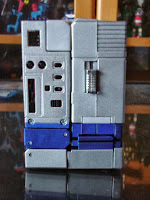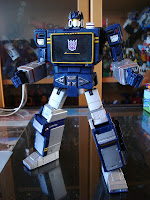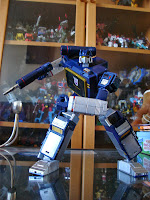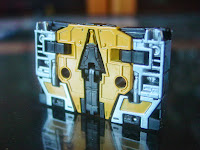I'm going to make life (slightly) easier on myself and deal here with Soundwave and Buzzsaw only, since they were packaged together in Generation 1. The remaining cassettes will be dealt with according to their G1 pairings as well: Rumble (red) & Ravage, Frenzy (blue) & Laserbeak.
Packaging
Hasbro have had a rather odd relationship with the Masterpiece series. MP01 got several production runs just as Optimus Prime (as opposed to Takara Tomy releasing several variations on Prime, plus 'Ultra Magnus' as MP02), their take on MP03/06/07 came out in G1 Starscream and Skywarp flavours (the US/UK version of the latter being somewhat superior in my opinion), MP05 was overlooked entirely, MP08 got a very belated release, MP09 was very much cut-down by Hasbro, while the US/UK counterpart to MP10 was basically identical to Takara Tomy's, then things started to get very patchy.
Masterpiece Soundwave (aka MP13) is being treated as the second 'new' Masterpiece from Hasbro (the first being the rather pointless MP11 repaint, Acid Storm), and as part of the 'Thrilling 30' lineup.To this end, it's been given a slightly more impressive branding, to make it clear that this is a Masterpiece figure, not one of the regular Generations toys... When I first saw the box, I was surprised by its sheer size - it's actually larger than just about any of the other Masterpiece boxes, including those from Takara Tomy. Considering the Masterpiece figures have actually become smaller in recent years, this is the first sign that perhaps the packaging is trying too hard to be a spectacle in and of itself. It's also the first time Hasbro's Masterpiece line has had it's own packaging style, rather than being based around whatever was standard for 'Classics'-style toys at the time, albeit in large plastic 'shell' packs rather than being entirely enclosed in cardboard. This thing doesn't even have windows.
The main box itself is pretty plain, printed in purple and silver, with embossing and glossy bits in strategic locations. One side has a white, embossed Decepticon insignia wrapped around one corner, the other has Soundwave's bio and a glossy insignia. Wrapped around this box is a belly band with images and brief details of the box's contents. The front has the usual (for Takara Tomy) dramatic picture of robot mode along with smaller alternate mode shots for Soundwave and his minions. The labelling at the bottom is reminiscent of the Takara Tomy Masterpieces, and there's even a bit of Japanese text up at the top which does actually translate as 'masterpiece', so well done Hasbro for not embarrassing yourselves utterly. On the back, Hasbro's 'Thrilling 30' logo puts Masterpiece Soundwave - quite rightly - in the 30th Anniversary collection... Making him pretty much the first of the Thrilling 30 (or those released in the UK, at least) that really deserves to be there.
Without question, this is the best presentation a Masterpiece figure from Hasbro has ever had but, once you open the box, you see how much empty space it contains. The plastic bubble shell packaging is far larger than it needed to be, not least because Soundwave comes packaged in robot mode. The shell is also far deeper than it needed to be, though, and the cassettes are packaged in an inefficient manner. Had Soundwave been in his alternate mode and the cassettes grouped together rather than spread around as they are, the package could have been halved in size without losing any of its overall impact.
The biggest disappointment, however, is the instruction sheet... which is just a 2-colour poster, just like any of the mainline toys. I guess it was foolish to expect a glossy 4-colour booklet, as with the earlier Takara Tomy packages, but surely Hasbro could have produced something more in keeping with the idea of a Masterpiece? Worse still, it deals only with his transformation, with no details about his accessories, not even how to store them.
It's a good effort... but just not very well thought-out. While it's immediately eye-catching, it turns out to be fairly insubstantial and very wasteful.






Alternate Mode:
There's never much to say about Soundwave's alternate mode... or is there? In many ways, looking at this is much like looking at the G1 original, 30 years ago. It's a tape deck... There has always been some confusion over whether Soundwave was intended to be a boombox kind of thing (like Blaster, only different) or a dictaphone and, certainly, the comics (specifically Guido Guidi's unused reinterpretation for All Hail Megatron) and third parties (BTS Toys' Sonicron) have tended toward the latter in recent years. Much of this confusion stems from the G1 TV series, in which Soundwave's size was more consistent with a boombox, but the G1 toy, based on Microman Microchange 'Cassette Man', is clearly labelled "Stereo Micro Cassette Recorder", making him a dictaphone, of sorts.
While that labelling is curiously absent in this version (unless you feel like shelling out for the Reprolabels set) it's pretty obvious that this is the same machine... albeit larger (not quite twice the size, but pretty close!) and with lots more molded detail. The biggest change to his size is the depth of the model - the sides extend further back and do a slightly better job of disguising his arms, which are otherwise quite obviously the robot's arms folded back. Each side has an assortment of molded sockets, switches and sliders, along with a small port on the bottom of the right side. Like the G1 original, the wheel on the left side and the switch on the right are mobile... only on mine, at least, the wheel barely moves and the switch is a little loose.
The front features a record/battery 'light' as a separate translucent red bit of plastic (rattling loose) within a chromed ring, which is a massive improvement on the G1 toy, on which that detail was merely a design on one of the stickers. The tape control and eject buttons are faithfully reproduced (and nicely chromed) while the cassette door is painted gold in such a way that - again, on mine - the paint seems to have been sprayed on from the right side, as the left edge is bare of paint.
One 'mistake' that has been carried over from the G1 model is that the speakers (or are they microphones?) are labelled for robot mode's legs rather than their position on the tape deck. Thus, the one on the left is labelled with an 'R' and the one on the right with an 'L'.
While the G1 original was certainly not perfect from behind, it at least won some points for looking reasonably solid, disguising Soundwave's weapons as enclosed batteries, and having a belt clip just for fun. This version features moldings that look like the belt clip/battery cover, but Soundwave's weapons are out in the open, and there's a large open space between the arms at the bottom. You can plug in another of his accessories there, but it neither fills the gap nor looks like something that should be there.
There's a (largely redundant) feature on either side, where a small grey door can open to reveal a compartment for Rumble/Frenzy's hand weapons, but each compartment can only hold one... while their piledriver accessories 'transform' into things that could be battery packs, and which can contain their hand weapons rather more effectively. In their 'battery pack' forms, the piledrivers can connect to Soundwave via the silver 'scanner' accessory, plugging into the port on the bottom of the righthand side.
As a nice homage to the Microchange original, there's even a headphone socket on the top which accepts a standard 5mm jack. It's a little loose, but I guess no-one felt the need to include the internal components of a socket since it can't really be used.
The colourscheme is pure G1 nostalgia, only slightly better handled. The blue stickers of the original have been replaced with metallic blue paint but, curiously, the colour matching is just as bad as it was with the stickers. This seems vers strange, considering this was an ideal opportunity to match the colours precisely and make the Masterpiece look just right. As it stands, it just looks like a homage to the G1 original's stickers.
One of the coolest features of the Masterpiece is that the cassette compartment can hold up to three of his minions. The rear wall of the compartment, molded with its tiny spool details, can be pushed back to accommodate each new tape, then a button on the back, just below the 'belt clip', pushes the next tape forward after the first is ejected. Unfortunately, the spring-loaded mechanism is likely to try to force its way all the way forward rather than just nudging one tape forward and, due to the inside of the tape door being rather inadequately molded, tapes are rarely scooped up as the door opens. Worse still, some have a habit of jamming inside the compartment.














Robot Mode:
As one might expect from a Masterpiece TransFormer, Soundwave's robot mode is replete with detail. This is, at once, a good thing and a bad thing. On the upside, many features of the G1 toy are present and improved upon. On the downside, there are molded features of the G1 toy that received stickers but which remain bare on the Masterpiece (unless, again, you get the Reprolabels set). Soundwave's arms come out very well, with the minimal required details brought out with paintwork... the legs aren't quite so lucky. Each of his knees features a recessed block which, on the original, were the locations of a pair of red stickers. There's also a strip on the upper part of the shin which features molded detail that should have been highlighted with a black stripe and coloured boxes.
What's really strange about these omissions is that there are areas on Soundwave's back - either side of the 'battery compartment' which have been painted silver. It's all well and good that these details have been so nicely highlighted... but they are on his back... and they can be covered up by his weapons. I'd have preferred Hasbro save a bit of money on that, and add a bit more painted detail to the front.
While the G1 version of Soundwave had weapons as entirely separate pieces, the Masterpiece version makes them rather more a part of the main robot. The shoulder launcher, for example, is actually attached to the right shoulder, and simply folds down the back for storage. The hand weapon is separate, but is self-contained rather than needing additional parts. The chromed gun barrel is nudged slightly out of its housing when the gun's handle is folded out, and then just needs to be manually extended.
The head sculpt it the one bone of contention for me... I really liked the G1 toy's head sculpt and, however well this model evokes Soundwave's appearance from the cartoon, I can't help but feel disappointed that it is the cartoon appearance rather than that of the toy. The early Masterpiece models struck a better balance between detail and accuracy between the G1 toys and cartoon appearances (Grimlock being an excellent case in point) but, more recently, robot modes - particularly the head sculpts - have been a bit of a let-down. There haven't been many new Soundwave toys that have had really good head sculpts (I think the Galaxy Force one is still my favourite, with TFPrime being a close second) and this one feels a bit smooth and featureless compared to the rest of the robot mode. What puzzles me about it is that his visor is yellow, like the G1 toy - if this was meant to be a full-on cartoon homage, it would have been red, like the Takara Tomy version.
Soundwave's weapons are decent upgrades to the G1 originals. Both feature more sculpted detail and paintwork, though it should be noted that the sort-of-vent things at the back of each have been left unpainted... which seems like a wasted opportunity (or the perfect opportunity... for Reprolabels). The shoulder-mounted missile launcher is mounted on a short arm behind his right shoulder which allows it to fold down Soundwave's back when not in use. While deployed it can be angled up and rotated left or right - the only thing in its way is Soundwave's head. The handgun, meanwhile, extends nicely, just like the G1 toy, but its grip folds away into the main cylinder and the barrel slides out from the end. It can be a little stiff, and I usually push it out from behind, using a screwdriver (or similar) inserted into the slot vacated by the grip. With a tab on each side of the grip, it can be held securely in either of Soundwave's hands.
One feature I've cleverly neglected to photograph is that raised sections on his forearms (on the outside of his wrist, where the red band appears) and his shoulders, Buzzsaw and Laserbeak can be made to perch on their master.































Accessories:
Aside from his minions, Soundwave comes with a small silver 'scanner' accessory (used in perhaps one episode of the TV series), a cassette door extension which is meant to represent his chest data readout (the Takara Tomy version of the model came with a couple of cards which could be inserted into the 'display'), a clear, colourless 'Energon Cube' (so you can pretend Soundwave is creating the cubes ready to be filled with Energon on the Decepticons' latest fuel run) and yet another miniature Megatron gun. Much of it seems to be identical to that which was included with MP01, but the stock has been remolded to appear more like the cartoon model - a thin round bar rather than the thicker, squarer block which mimicked the G1 toy. It still has the unnecessary hinged section which broke on my MP01 Megatron accessory. The only other part that seems to have been remolded is the sliding rear section of the grip, which now looks a bit more like the grip on MP05. The sight is identical except that it doesn't have the painted red dot.
To attach the scanner, one of his hands must be rotated back into the forearm, revealing the speaker detail molded into the inner surface of the flap. It's a cool and wholly unnecessary bit of detailing, harking back to the forearm communicator panels on MP01. The 'display' and Energon cube accessories attach nice and firmly to the cassette door and, while the Megatron gun has no tabs to slot into Soundwave's palms, its size makes it a secure fit.






Masterpiece Soundwave's transformation is broadly identical to the G1 version, just with a few extra steps and additional features. The legs do much the same, but the feet are far more complicated. The arms are exactly the same, but the shoulder joint is much improved - far less likely to go limp after many years of posing. The most significant differences are the groin area (which didn't actually transform at all in the original, but now folds together then back between the legs) and the head (which is now properly stowed in a compartment with a hinged lid in the centre of his back, neatly explaining the need to store his weapons externally).
Articulation is hugely improved, however. Finally Soundwave has knees that bend the right way, and aren't prone to sagging forward. The double-jointed elbow and bicep swivel, along with the individually jointed index finger, mean that Soundwave can actually push his own eject button. Some folks have complained about the weird 'double' hip joints and I have to confess they seem a little wobbly compared to most of the other joints, but I don't see them breaking anytime soon. All the joints have an excellent range of motion, possibly the best in the Masterpiece line up to this point... Almost ironic, considering Soundwave rarely got involved in any of the action in the TV show.
Buzzsaw
I was always puzzled by the fact that, in the TV show, Laserbeak was Soundwave's go-to robo-bird for spying missions when his function, according to his Tech Specs, was 'interrogation'. Though his bio didn't expand upon that point, it did mention that he was 'noticeably not brave'. Buzzsaw virtually never appeared in the show, despite him being the one listed as the spy. Buzzsaw was my introduction to the so-called 'condor cassettes' and, as I stated in my write-up of the G1 version, it stands up very well even today... But is it better than the Masterpiece interpretation?
Cassette Mode:
Straight away, this version loses points for having way more seams and a less convincing tape mode. All the colour is paintwork rather than stickers, and so much of the detail has been cut. It's also missing the tape detail in the 'window' between the spools, partly because you kind of have to push his head out via the little 'button' in the slot. On the upside, the increased visibility of seams suggests an increase in the complexity of transformation, which is usually a good thing in my books.
The back of the 'cassette' is no more or less obviously not cassette detail than the G1 version, and actually shows that all of the Masterpiece version's weapons are contained within the 'cassette', which is very impressive.
Other than that... there's not a lot to say. It's another TransFormers microcassette, made to the actual size of a microcassette.


Robot Mode:
Here's where things get all kinds of awesome... because this thing is very clearly based on the G1 animation models for Buzzsaw and Laserbeak. The head is more refined and not as boxy, the wings are more like those of an aircraft, the feet are closer to the implied look of the G1 version's moldings and his weapons are in better proportion to the rest of his body.
As with cassette mode, what colouring exists is painted on rather than applied on stickers and, like the animation model, it's very simplistic - yellow recessed panels on his wings are about the extent of it, other than tampographed Decepticon insignia in the square panel on each wing.
The excellent head sculpt has its beak and eyes picked out in yellow paint as well as a dark gunmetal panel in the forehead. This actually opens up to reveal the camera-thing Laserbeak uses at the beginning of the Animated movie (and nowhere else, as I recall... I mean, come on, he has eyes... why does he need a camera in his head?) - a pretty cool feature to cram into such a small noggin.
There are two things I'm disappointed about in this model. The first is that the secondary guns (molded against the body, just below the wings on the G1 version) are not present on this Masterpiece interpretation. The second is that Buzzsaw's secondary colour, throughout the model, is yellow rather than gold. I guess gold may not have worked as well against the silver paint on the wings and weapons/boosters, but Buzzsaw was gold, damnit, not yellow!








Transformation is very similar to the G1 version, but the way the wings fold out is quite different. I'm not sure which I prefer, to be honest. The wings on this are much more believable... but those of the G1 model are more less 'drone aircraft' and more 'robot bird'. Particularly impressive is the way the weapons/boosters have been integrated into the main model, and how this small, flat cassette becomes a nicely three-dimensional bird. I also much prefer the way the head is handled, on balance, if only because the neck on this one is less likely to break.
The condor cassettes could never be described as 'well articulated', and the Masterpiece version is little different. The wings are probably less poseable than those of the original, on balance, but the feet are much more mobile, allowing him to perch in a variety of postures. The feet also rotate at the ankle, but this joint seems rather floppy. The head and neck have a single pinned hinge each so, while he still can't turn his head from side to side, he has as much head movement as the original.
The fact that this turned up at UK retail at all was a massive surprise. The moment the Japanese version was announced, I was keen to get one, but the Hasbro Masterpiece package turned out to be better due to its improved G1 (toy) accuracy and because it was packaged with all five of the first Masterpiece cassettes. I have to admit to feeling very let-down when Takara repainted MP Soundwave as Soundblaster (predictable though that move may have been) and made a Masterpiece Ratbat that was exclusive to the MP Soundblaster package.
The Masterpiece line got off to a less than ideal start, with a version of Optimus Prime which was great for the time, and features some elements which are still better than the newer, smaller version, but being immediately repainted into MP02 'Ultra' Magnus and subsequently into any number of alternate versions of Prime rather diluted the Masterpiece brand from the get-go. While I absolutely adore MP03, it is a divisive model (and also got repainted several times!), then the next unique mold was MP05, the Masterpiece interpretation of G1 Megatron (almost universally despised because it's more like the G1 toy than the G1 cartoon character it strives to emulate). It's difficult to decide what kind of Masterpiece this is... In some ways, it's a love letter to the Microman Microchange/G1 toy, but in others it's clearly based upon the G1 TV series animation model. It's a perfect illustration of how dichotomous the line became.
The fact is that it's an awesome package. Soundwave on his own would be worth picking up, but (assuming you're a G1 fan and can afford it... and still find it) Soundwave and five Masterpiece cassettes is something you'd be daft to miss out on.

No comments:
Post a Comment